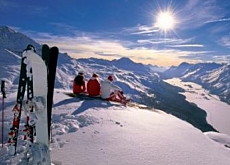
How to sell skiing the American way

The answer to overcoming the malaise affecting European – and Swiss – ski resorts could be found in the United States.
Tourism experts tell swissinfo that ski resorts in the Alps will have to introduce radical reforms if they are to remain competitive, and the American industry could serve as a model.
The recent International Tourism Symposium held in Zermatt started with a sobering statistic: there are more charter flights out of London taking British skiers to North American resorts than the Alps.
The experts cited many reasons for Europe’s declining competitiveness including: high costs, indifferent service, inflexibility, outdated marketing techniques, and a lack of government support.
Alain Dupeyras, head of the tourism programme at the Organisation for Economic Cooperation and Development (OECD), said the European industry was also characterised by a predominance of small operators who lacked the clout to lobby effectively.
Microcosm
In Switzerland the European problem can be seen in microcosm. There are around 600 ski lift companies spread across more than 200 resorts in the country, and only a dozen of the latter – according to analysts – have growth potential.
Since most Swiss resorts are small and located in peripheral regions, they have low cash flow, an inability to attract investment capital, and are crippled by high costs of labour, services and food, according to professor Thomas Bieger of St Gallen University.
“The Swiss ski industry is split into two camps: bigger companies [in large resorts] that are innovative and can keep pace with global developments, and too many operators in small ski areas who don’t have the means to invest.”
Bieger told swissinfo that consolidation is one of the answers to the problem. “Only then do you have enough money to make investments.”
The Swiss industry has seen a number of mergers in recent years and more are on the cards, but the speed of change has been slow.
New challenges
And the structural problems are being exacerbated by new challenges, according to French consultant, Joël Gayet.
He said they include a demographic shift – skiers are getting older, increased competition from seaside resorts, a preference for shorter ski holidays, the unpredictability of snow conditions due to climate change and an increasing frequency of global crises.
The head of the National Ski Areas Association in the US, Michael Berry, said the American industry had successfully taken on many of the challenges, with sales of ski passes jumping from an average of 53 million in the 1980s and 1990s to 57 million in this decade.
While the demographic shift in the US from urban to rural regions, particularly to mountainous states in the west, accounts for much of the growth, Berry points out that 20 per cent of American resorts would have gone bankrupt if they had not reformed.
Way forward
“I think the single most important thing is the notion that the way we’ve done it in the past is not the way we can do it in the future,” Berry told swissinfo.
“We now focus on innovation [for newcomers to the sport].”
Instead of pumping money into new lifts on difficult slopes for advanced skiers and snowboarders, Berry said the emphasis has been on improving and introducing facilities and services for beginners.
Across the US, they are catered to with separate learning areas and rental facilities.
The runs are divided into different terrains to keep both skiers and snowboarders happy, and the latest technology such as comfortable, high-speed lifts is designed to keep older customers on skis.
He also said flexible pricing had provided a boost, with resorts rewarding repeat customers and discounting season passes.
Snowboards for skateboards
Berry also concluded that snowboarding had cut across all ethnic and class lines, with second generation Hispanics, for instance, trading in their skateboards for snowboards in winter.
While flexible pricing remains controversial in the European industry, Bieger said there was much to be learned from the American model.
Skiing has become less popular among the Swiss with resorts in the country reporting a five per cent drop in sales to residents, and that has been partly blamed on the increase in the immigrant population.
Many foreign residents, the argument goes, do not encourage their children to ski, since many come from countries with no tradition of winter sports.
“I think ski resorts should make more of an effort to introduce children of immigrants to the sport,” Bieger concluded.
swissinfo, Dale Bechtel in Zermatt
There are 650 ski lift companies in around 230 Swiss ski resorts, employing 11,000 people.
Many are key to the economic survival of mountain towns and villages in the Swiss Alps.
The ski season accounts for between 70-80% of turnover in most mountain resorts.
However, employment growth rate in peripheral regions is 1.36% compared to a national average of 1.86% – and far below Swiss cities.
And ski industry officials predict that 10-20% of Swiss resorts will disappear over the next decade.

In compliance with the JTI standards
More: SWI swissinfo.ch certified by the Journalism Trust Initiative





























You can find an overview of ongoing debates with our journalists here . Please join us!
If you want to start a conversation about a topic raised in this article or want to report factual errors, email us at english@swissinfo.ch.